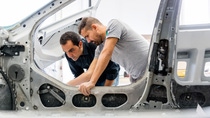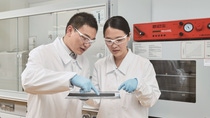Sustainability
BASF drives chemistry for climate innovation

By 2030, three out of every five of us will live in a city. The development of cities has boomed with population growth, bringing wealth and modern lifestyles. However, such development also consumes significant natural resources. How might we build mega-cities with larger and denser populations, using fewer scarce natural resources? How might we mitigate the influence of human activities on climate change? How might we create a viable future with enhanced quality of life -- for everyone?
At BASF, we believe that chemistry is an enabler to address all these challenges. Our innovative solutions are already helping to build the sustainable cities of the future – and we are committed to seeing these issues through.
Driving towards sustainable mobility
Transportation is vital to urban development. Looking back to the 20th century, modern cities were transformed by automobiles. Cars represented both progress and independence. But today, they are often associated with traffic jams and air pollution.
To remain livable and fit for the future, cities must become sustainably mobile. BASF automotive solutions both lighten the environmental footprint of mobility and support the achievement of the United Nations’ Sustainable Development Goals.
One important example is catalysts. Since developing the first catalytic converter in 1973, BASF catalytic technologies have eliminated over one billion tons of pollutants. BASF’s FWC™ (Four-Way Conversion) catalyst can remove Particulate Matter (PM), as well as CO (Carbon Monoxide), HC (Hydrocarbons) and NOx (Nitrogen Oxides) from gasoline-engine exhaust in a single component.
Light-weighting is another important strategy to save energy and reduce emissions. BASF lightweight solutions include composite materials, polyurethane systems, and metal injection molding solutions, among others. In addition to reducing weight, these products improve the strength and elasticity of structures and parts, making them safe and more durable.

Electromobility, especially in combination with renewable energy, is an important contribution towards addressing both mobility and climate needs. BASF is conducting extensive research to make batteries more powerful, more reliable and more affordable. By 2025, BASF aspires to deliver an electric midsize car with twice the real driving range (from 300 km to 600 km on a single charge) and battery lifetime, half the battery size and cost, and a charging time reduced to 15 minutes.

Sustainable construction supporting climate-ready infrastructure
Buildings play a principal role in cities. They are also energy guzzlers, accounting for one-third of energy consumption in metropolises globally. The challenge becomes how to make them significantly more sustainable. One powerful tool is the Passive House approach. A Passive House is a building with ultra-low energy-consumption that only uses “passive” methods, such as natural ventilation and lighting, to create a comfortable indoor environment. BASF is committed to promoting and developing passive houses in China. Our insulation solutions for walls and roofs, as well as flooring systems, waterproofing systems and tiling systems, have helped save up to 90% of the energy normally used for heating and cooling in China.

Changes in global climate have amplified the risk of extreme weather disasters. When disasters strike, they damage not only infrastructure but also peoples' well-being. That is why many countries, including China, are moving to upgrade infrastructure for the advent of climate change. Climate-ready infrastructure means anticipating, and being strong enough to withstand, the onslaught of heat waves, rain, snow, wind and hail.
How do you keep the power on during a storm? Using high-strength and high-flexibility polyurethane (PU), BASF developed a composite utility pole. Compared to conventional concrete utility poles, the PU poles are extremely lightweight and robust. They can withstand heavy snow and strong winds, and are simple and fast to install even in remote areas. When natural disasters occur, communities can power on – and recover more quickly.
To tackle flooding, China has introduced the Sponge City initiative. It aims to overcome flooding by absorbing and re-using at least 70% of rainwater. BASF’s intelligent PU solution, Elastopave® can help. With its water-permeable and porous structure, water drains through Elastopave easily, absorbing an estimated 4,000 liters of water per hour per square meter. This enables replenishment of aquifers, improving the water circulation system and, in the long run, creating a greener and cooler environment.

Improving quality of life
As natural resources become increasingly scarce, it is becoming more urgent to use them in a sustainable and wise manner.
Water has been called the essence of human life. However, many cities have insufficient water to meet demand. How might they quench their growing thirst? One option for coastal cities is desalinated seawater. BASF ultrafiltration membranes can help. With tiny pores of about 20 nanometers in diameter, BASF’s inge® Multibore® ultrafiltration membranes purify water by effectively intercepting algae, colloids, bacteria, viruses and other harmful substances. The Multibore system has already been used in several urban sewage and drinking water projects in China.
If sustainability is the question, chemistry is essential to the answer. BASF is the chemical partner of choice for companies serious about meeting the sustainability needs of the future, with the best resources and intelligence available today.
.jpg)
If sustainability is the question, chemistry is essential to the answer. BASF is the chemical partner of choice for companies serious about meeting the sustainability needs of the future, with the best resources and intelligence available today.